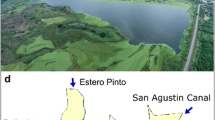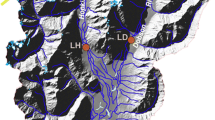Abstract
Holocene loss-on-ignition (LOI) records were developed for radiocarbon-dated sediment cores from 20 lakes in the Uinta Mountains of northeastern Utah, USA. The hydrogeomorphic setting of each lake was characterized, permitting an analysis of connections between LOI values and lake setting. Median LOI values exhibit a significant negative correlation with lake elevation, with the range of elevations and the maximum slope of the watershed, with the extent of ice/snow and exposed rock in the watershed, and with the volume of through-flowing water. In contrast, LOI is positively correlated with the extent of forest cover and wetlands in the watershed. In addition, forward stepwise linear modeling demonstrates that lake area/lake depth ratio is a significant negative predictor for median LOI, that shoreline complexity is a significant positive predictor for maximum LOI, and the standard deviation of LOI values is greater in lakes surrounded by watersheds with more wetlands and surface water. Some LOI time series contain excursions at finer temporal scales that are recorded synchronously in adjacent lakes, however many excursions appear in only a single record. Similarly, step changes in LOI that are clear in some records are not preserved in the sediments of nearby lakes. Over longer timescales, some LOI records are essentially constant during the Holocene. In contrast, some lakes record steadily rising LOI values, and approximately half of the lakes have complicated LOI records with millennial-scale variability. Lakes with large surface area, large area/depth ratios, large watershed area/lake area ratios, rugged watersheds, and extensive ice/snow cover are more likely to record steady LOI values over time. The degree to which LOI records from neighboring lakes vary emphasizes that lacustrine proxy records reflect a strong filtering effect, whereby the signal of an external forcing is recorded to varying degrees depending on the nature of the lake and surrounding watershed.







Similar content being viewed by others

References
Anderson NJ, Liversidge AC, McGowan S, Jones MD (2012) Lake and catchment response to Holocene environmental change: spatial variability along a climate gradient in southwest Greenland. J Paleolimnol 48:209–222
Anderson L, Brunelle A, Thompson RS (2015) A multi-proxy record of hydroclimate, vegetation, fire, and post-settlement impacts for a subalpine plateau, central Rocky Mountains, U.S.A. Holocene 25:932–943
Atwood WW (1908) Lakes of the Uinta Mountains. Bull Am Geogr Soc 40:12–17
Atwood WW (1909) Glaciation of the Uinta and Wasatch mountains, vol 61. US Government Printing Office, Washington
Balascio NL, Bradley RS (2012) Evaluating Holocene climate change in northern Norway using sediment records from two contrasting lake systems. J Paleolimnol 48:259–273
Ball DF (1964) Loss-on-ignition as an estimate of organic matter and organic carbon in non-calcareous soils. Eur J Soil Sci 15:84–92
Ben-Dor E, Banin A (1989) Determination of organic matter content in arid-zone soils using a simple “loss-on-ignition” method. Commun Soil Sci Plant Anal 20:1675–1695
Blaauw M (2010) Methods and code for ‘classical’ age-modelling of radiocarbon sequences. Quat Geochronol 5:512–518
Bleckner T (2005) A conceptual model of climate-related effects on lake ecosystem. Hydrobiologica 533:1–14
Brown TA, Nelson DE, Mathewes RW, Vogel JS, Southon JR (1989) Radiocarbon dating of pollen by accelerator mass spectrometry. Quat Res 32:205–212
Cohen AS (2003) Palaeolimnology. Oxford University Press, New York
Corbett LB, Munroe JS (2010) Investigating the influence of hydrogeomorphic setting on the response of lake sedimentation to climatic changes in the Uinta Mountains, Utah, USA. J Paleolimnol 44:311–325
Craft CB, Seneca ED, Broome SW (1991) Loss on ignition and Kjeldahl digestion for estimating organic carbon and total nitrogen in estuarine marsh soils: calibration with dry combustion. Estuaries Coasts 14:175–179
D’Arcy P, Carignan R (1997) Influence of catchment topography on water chemistry in southeastern Quebec Shield lakes. Can J Fish Aquat Sci 54:2215–2227
Davies BE (1974) Loss-on-ignition as an estimate of soil organic matter. Soil Sci Soc Am J 38:150–151
Dean WE Jr (1974) Determination of carbonate and organic matter in calcareous sediments and sedimentary rocks by loss on ignition; comparison with other methods. J Sediment Petrol 44:242–248
Dehler CM, Porter SM, De Grey LD, Sprinkel DA, Brehm A (2007) The Neoproterozoic Uinta Mountain Group revisited; a synthesis of recent work on the Red Pine Shale and related undivided clastic strata, northeastern Utah, U. S. A. Spec Publ Soc Sediment Geol 86:151–166
Fall PL, Davis PT, Zielinski GA (1995) Late quaternary vegetation and climate of the Wind River Range. Quat Res 43:393–404
Gergel SE, Turner MG, Kratz TK (1999) Dissolved organic carbon as an indicator of the scale of watershed influence on lakes and rivers. Ecol Appl 9:1377–1390
Håkanson L (2005) The importance of lake morphometry and catchment characteristics in limnology–ranking based on statistical analyses. Hydrobiologia 541:117–137
Heiri O, Lotter AF, Lemcke G (2001) Loss on ignition as a method for estimating organic and carbonate content in sediments; reproducibility and comparability of results. J Paleolimnol 25:101–110
Johnson BG, Jimenez-Moreno G, Eppes MC, Diemer JA, Stone JR (2013) A multiproxy record of postglacial climate variability from a shallowing, 12-m deep sub-alpine bog in the southeastern San Juan Mountains of Colorado, USA. The Holocene 23:1028–1038
Konen ME, Jacobs PM, Burras CL, Talaga BJ, Mason JA (2002) Equations for predicting soil organic carbon using loss-on-ignition for north central US soils. Soil Sci Soc Am J 66:1878–1881
Kurek J, Cwynar LC, Spear RW (2004) The 8200 cal yr BP cooling event in eastern North America and the utility of midge analysis for Holocene temperature reconstructions. Quat Sci Rev 23:627–639
Laabs BJC, Refsnider KA, Munroe JS, Mickelson DM, Applegate PJ, Singer BS, Caffee MW (2009) Latest Pleistocene glacial chronology of the Uinta Mountains: support for moisture-driven asynchrony of the last deglaciation. Quat Sci Rev 28:1171–1187
Lehmann EL (1975) Nonparametrics: statistical methods based on ranks. Holden-Day, San Francisco
Mensing SA, Southon JR (1999) A simple method to separate pollen for AMS radiocarbon dating and its application to lacustrine and marine sediments. Radiocarbon 41:1–8
Munroe JS (2006) Investigating the spatial distribution of summit flats in the Uinta Mountains of northeastern Utah, USA. Geomorphology 75:437–449
Munroe JS (2007) Exploring relationships between watershed properties and Holocene loss-on-ignition records in high-elevation lakes, southern Uinta Mountains, Utah, U.S.A. Arct Antarct Alp Res 39:556–565
Munroe JS, Laabs BJC (2009) Glacial Geologic Map of the Uinta Mountains Area, Utah and Wyoming. Utah Geological Survey Miscellaneous Publication, Salt Lake City
Munroe JS, Laabs BJ (2017) Combining radiocarbon and cosmogenic ages to constrain the timing of the last glacial–interglacial transition in the Uinta Mountains, Utah, USA. Geology 45:171–174
Nesje A, Dahl SO (2001) The Greenland 8200 cal. yr BP event detected in loss-on-ignition profiles in Norwegian lacustrine sediment sequences. J Quat Sci 16:155–166
Pallasser R, Minasny B, McBratney AB (2013) Soil carbon determination by thermogravimetrics. PeerJ 1:e6
Prepas EE, Planas D, Gibson JJ, Vitt DH, Prowse TD, Dinsmore WP, Halsey LA, McEachern PM, Paquet S, Scrimgeour GJ (2001) Landscape variables influencing nutrients and phytoplankton communities in Boreal Plain lakes of northern Alberta: a comparison of wetland- and upland-dominated catchments. Can J Fish Aquat Sci 58:1286–1299
Rasmussen JB, Godbout L, Schallenberg M (1989) The humic content of lake water and its relationship to watershed and lake morphometry. Limnol Oceanogr 34:1336–1343
Reasoner MA (1993) Equipment and procedure improvements for a lightweight, inexpensive, percussion core sampling system. J Paleolimnol 8:273–281
Reimer PJ, Bard E, Bayliss A, Beck JW, Blackwell PG, Ramsey CB, Buck CE, Cheng H, Edwards RL, Friedrich M et al (2013) IntCal13 and Marine13 radiocarbon age calibration curves 0–50,000 years cal BP. Radiocarbon 55:1869–1887
Rubensdotter L, Rosqvist G (2003) The effect of geomorphological setting on Holocene lake sediment variability, northern Swedish Lapland. J Quat Sci 18:757–767
Schindler DW (1971) A hypothesis to explain differences and similarities among lakes in the Experimental Lakes Area, northwestern Ontario. J Fish Board Can 28:295–301
Sears J, Graff P, Holden G (1982) Tectonic evolution of lower Proterozoic rocks, Uinta Mountains, Utah and Colorado. Geol Soc Am Bull 93:990–997
Shaw JD, Long JN (2007) Forest ecology and biogeography of the Uinta Mountains, USA. Arct Antarct Alp Res 39:614–628
Shuman B (2003) Controls on loss-on-ignition variation in cores from two shallow lakes in the northeastern United States. J Paleolimnol 30:371–385
Strahler AN (1952) Dynamic basis of geomorphology. Geol Soc Am Bull 63:923–938
Sutherland RA (1998) Loss-on-ignition estimates of organic matter and relationships to organic carbon in fluvial bed sediments. Hydrobiologia 389:153–167
Wang Q, Li Y, Wang Y (2011) Optimizing the weight loss-on-ignition methodology to quantify organic and carbonate carbon of sediments from diverse sources. Environ Monit Assess 174:241–257
Wright AL, Wang Y, Reddy KR (2008) Loss-on-ignition method to assess soil organic carbon in calcareous Everglades Wetlands. Commun Soil Sci Plant Anal 39:3074–3083
Xenopoulos MA, Lodge DM, Frentress J, Kreps TA, Bridgham SD, Grossman E, Jackson CJ (2003) Regional comparisons of watershed determinants of dissolved organic carbon in temperate lakes from the Upper Great Lakes region and selected regions globally. Limnol Oceanogr 48:2321–2334
Zielinski GA (1989) Lacustrine sedimentary evidence opposing Holocene rock glacier activity in the Temple Lake Valley, Wind River Range, Wyoming, U.S.A. Holocene 21:22–33
Acknowledgements
B. Laabs and D. Munroe contributed significantly to the success of this project. The coring equipment was built at Middlebury College. C. Anderson, D. Berkman, L. Corbett, M. Devito, S. Munroe, N. Oprandy, C. Plunkett, and C. Rodgers provided crucial support in the field. Logistical support was provided by the Ashley National Forest. Funding was provided by NSF EAR-0345112. The Leco TGA was purchased with an award from Vermont EPSCoR.
Author information
Authors and Affiliations
Corresponding author
Electronic supplementary material
Below is the link to the electronic supplementary material.
Rights and permissions
About this article
Cite this article
Munroe, J.S. Hydrogeomorphic controls on Holocene lacustrine loss-on-ignition records. J Paleolimnol 61, 53–68 (2019). https://doi.org/10.1007/s10933-018-0044-x
Received:
Accepted:
Published:
Issue Date:
DOI: https://doi.org/10.1007/s10933-018-0044-x



